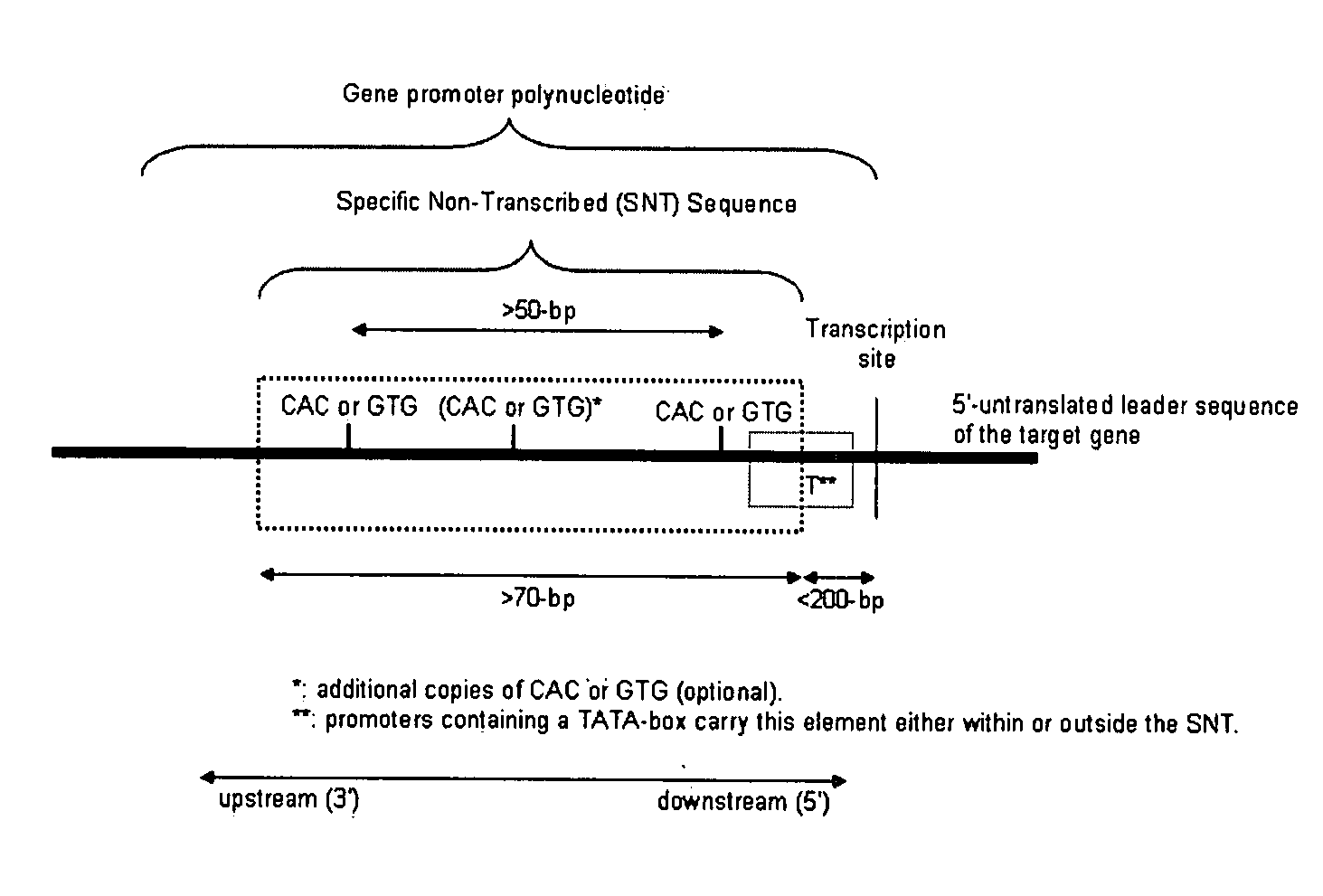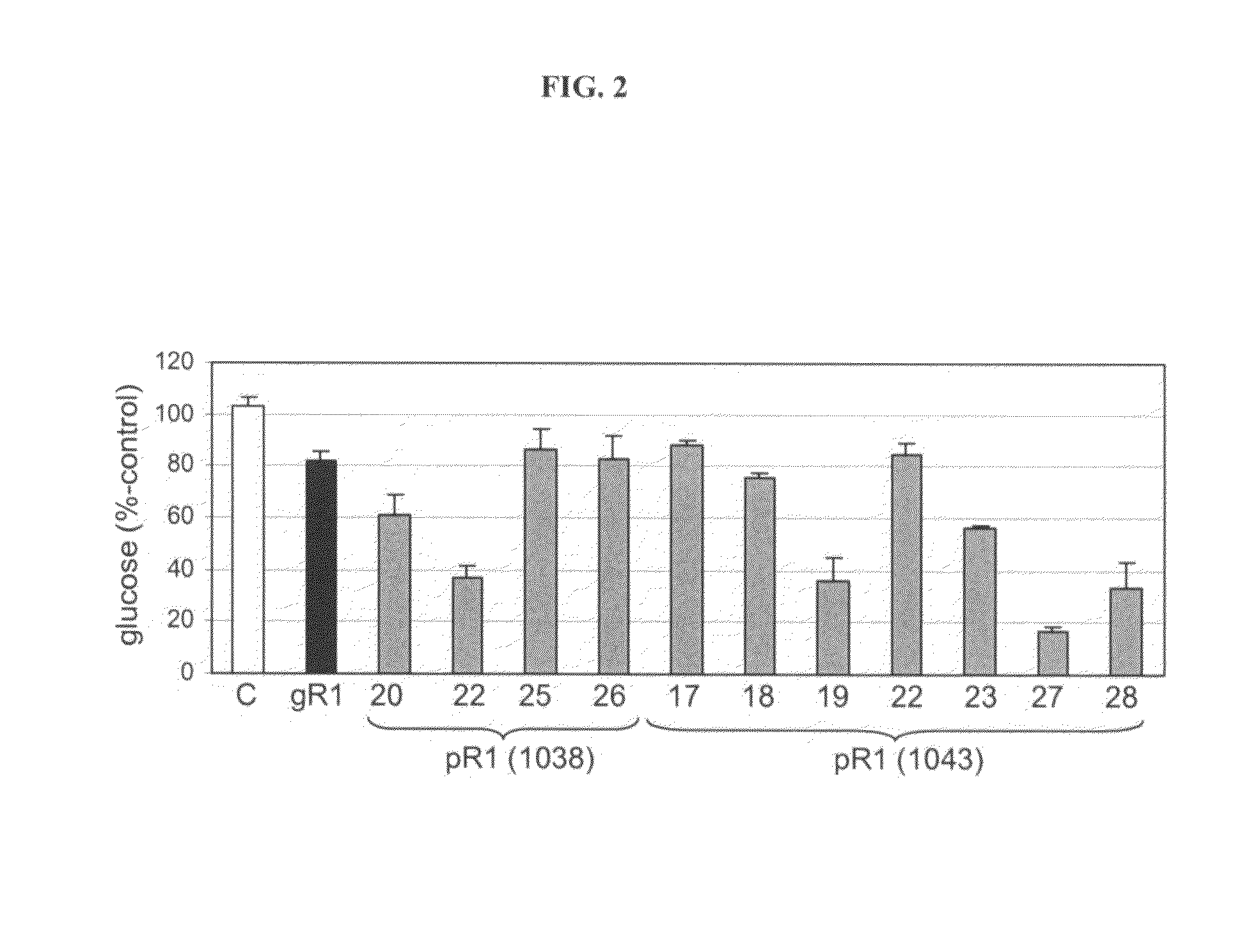Promoter-based gene silencing
- Summary
- Abstract
- Description
- Claims
- Application Information
AI Technical Summary
Benefits of technology
Problems solved by technology
Method used
Image
Examples
Example
Example 1
Characteristics of Promoter Fragments for Silencing a Heterologous Gene
[0188]A tobacco plant expressing the beta glucuronidase (gus) gene represents our heterologous test gene system. This plant contains the gus gene driven by the strong 35S promoter of figwort mosaic virus (FMV). It was retransformed with three different silencing constructs. Each of these silencing constructs contained two “target” FMV promoter fragments positioned as inverted repeat between two “driver promoters. The fragments of the inverted repeats were derived from the upstream (SEQ ID NO. 1), middle (SEQ ID NO. 2), and downstream (SEQ ID NO. 3) part of the FMV promoter. Interestingly, the first two constructs did not trigger any gus gene silencing whereas the third construct was extremely effective. This third fragment is characterized in that it (a) comprises a 301-bp sequence from the non-transcribed 5′ regulatory sequences that precede the target gus gene, wherein the 3′-end of the sequence is 41-...
Example
Example 2
General Concept of the Promoter-Based Silencing of Endogenous Genes
[0191]Gene silencing is accomplished by defining the promoter of the target gene, and identifying an SNT fragment (a) comprising a sequence from the non-transcribed 5′ regulatory sequences that precede a target gene, wherein the 3′-end of the sequence may not be further than 150-250 bp upstream from the transcription start, preferably not more than 150-bp upstream, and wherein the sequence comprises at least two CAC / GTG trinucleotides that are separated by at least 50 base pairs; consists of at least 80 contiguous base pairs that may or may not contain an extended 19-bp TATA box region, and (b) not comprising sequences derived from that target gene itself. The SNT fragment is used to produce a silencing construct, which would typically contain two copies as inverted repeat or at least four copies as direct repeat. These structures are operably linked to regulatory sequences that would promote expression of t...
Example
Example 3
First Example of an Effective Transgenic Approach Towards the Silencing on an Endogenous Gene
The Potato Tuber-Expressed R1 Gene
[0192]The sequence of the promoter of the potato starch-associated R1 gene together with leader and start codon, is shown in SEQ ID NO: 4. Two copies of an (342-bp) R1 SNT fragment (SEQ ID NO: 5) were inserted as inverted repeat between either two convergently oriented promoters of the GBSS promoter (in plasmid pSIM1038) or a GBSS and AGP promoter in convergent orientation (in plasmid pSIM1043). The resulting binary vectors were used to produce transformed potato plants. Transgenic pSIM1043 plants were allowed to develop min-tubers tubers, which were stored for a month at 4° C. Glucose analysis of the cold-stored tubers (Megazyme, Ireland) demonstrated that the transformed plants accumulated less glucose than untransformed control plants (FIG. 2). Multiple genes are involved in the degradation of starch into reducing sugars and therefore the present...
PUM
| Property | Measurement | Unit |
|---|---|---|
| Fraction | aaaaa | aaaaa |
| Fraction | aaaaa | aaaaa |
| Fraction | aaaaa | aaaaa |
Abstract
Description
Claims
Application Information
 Login to View More
Login to View More - R&D
- Intellectual Property
- Life Sciences
- Materials
- Tech Scout
- Unparalleled Data Quality
- Higher Quality Content
- 60% Fewer Hallucinations
Browse by: Latest US Patents, China's latest patents, Technical Efficacy Thesaurus, Application Domain, Technology Topic, Popular Technical Reports.
© 2025 PatSnap. All rights reserved.Legal|Privacy policy|Modern Slavery Act Transparency Statement|Sitemap|About US| Contact US: help@patsnap.com



